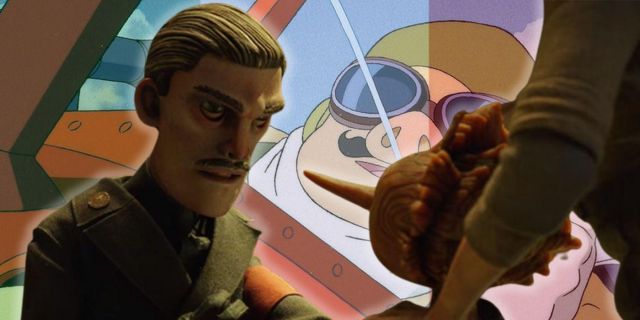In a year with an abnormally large number of high-profile Pinocchio movies, it is clear that Netflix’s Guillermo Del Toro’s Pinocchio is the winner by a mile. A love letter to claymation and a searing indictment of fascism, the whimsical movie is set against a clear backdrop of hatred and evil, even as its pinewood protagonist sings, skips and babbles his way into audiences’ hearts. It’s difficult to hit a balance between the two, so it’s odd to see two entirely different movies set in the same era undertake and succeed in this selfsame area. Where 2022 welcomed Pinocchio, 1992 welcomed Studio Ghibli’s Porco Rosso.
Porco Rosso starred Shūichirō Moriyama/Michael Keaton as Marco, a man who had been cursed to resemble a pig and flew bounty missions in his signature red plane. What’s more relevant, though, is that Marco is flying across skies that are slowly being taken over by fascist Italy in the days immediately preceding WWII. Both Porco Rosso and Pinocchio are whimsical films with dark undertones, and the similarities do not stop at locale and theme. Though the movies are quite dissimilar at face value, fans of one would do well to look into just how the other can further inform their education or entertainment, whichever comes first.
Pinocchio and Ghibli’s Porco Rosso are Master Classes in Animation

Any fan of anime, animation, cartoons or movies will likely concur that standing up to a Studio Ghibli piece of any sort is a major accomplishment, and Pinocchio manages as well as any. Its gorgeous scenery and careful imagery are some of the best among claymation features. It masterfully accepts the gorgeous Italian countryside and passes it through an idyllic lens, much as Porco Rosso does with the islands around and about the peninsula. Both animations are just as much love letters to their style of animation as they are to the gorgeous Mediterranean locale, even though they emphasize very different parts of it.
Within these emphasized portions, however, one can see a distinct similarity in the way that the films handle fascism. Both use the minor ways that citizenry interact to complement the borad posters and shady cars. What’s more, both make a goal of having the fascists trounced by the protagonists, whether by land and air in the case of Porco Rosso or by song and dance as with Pinocchio. Both use their medium to great effect in portraying both active and passive aspects of the suppressive forces of fascism. In Porco Rosso, it’s in big chase scenes and dogfights. In Pinocchio, it’s subtle and delicate action.
Pinocchio and Porco Rosso Are Ideological Birds of a Feather

It’s rather rare that a movie would encourage fascism, so suffice to say that both Pinocchio and Porco Rosso fall firmly in the “fascism is bad” category. However, they are not necessarily simple in execution, as both focus on the complexities therein. Pinocchio and Porco Rosso both demonstrate that even those who follow along with fascism may not be so committed, or may only be so in order to further their own grasps for power.
Guillermo Del Toro and Hayao Miyazaki have always been able to bring humanity to monsters, and both of these movies, despite their 30-year separation, work similarly to show that even the most malevolent being on the surface is a human. It’s a delicate balance to say that fascism is inherently bad even if fascists are only flawed, but both films manage the topic with aplomb.
It’s difficult to know if Pinocchio will have much cultural impact. Among such giants as My Neighbor Totoro and Howl’s Moving Castle, Porco Rosso tends to get left behind. Likewise, Del Toro simultaneously has to compete with his own extensive catalog as well as great claymation films, like those of LAIKA Studios. However, by taking the time to watch these movies — for their beauty, their message or just because — there is much to be gained, even if it is just noticing that that flying pig has a bit more in common with the pine puppet than it appears at first glance.















Leave a Reply